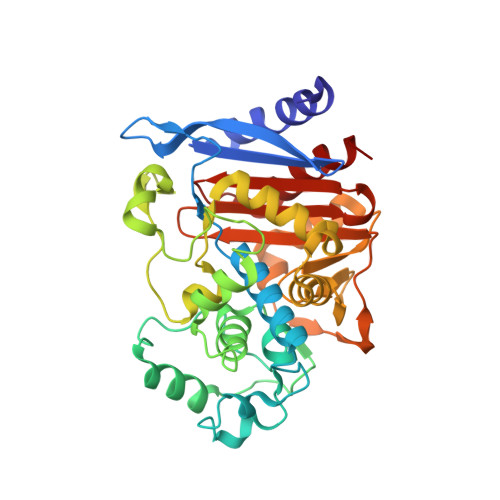Structure-based approach for binding site identification on AmpC beta-lactamase.
Powers, R.A., Shoichet, B.K.(2002) J Med Chem 45: 3222-3234
- PubMed: 12109906
- DOI: https://doi.org/10.1021/jm020002p
- Primary Citation of Related Structures:
1KDS, 1KDW, 1KE0, 1KE3, 1KE4 - PubMed Abstract:
Beta-lactamases are the most widespread resistance mechanism to beta-lactam antibiotics and are an increasing menace to public health. Several beta-lactamase structures have been determined, making this enzyme an attractive target for structure-based drug design. To facilitate inhibitor design for the class C beta-lactamase AmpC, binding site "hot spots" on the enzyme were identified using experimental and computational approaches. Experimentally, X-ray crystal structures of AmpC in complexes with four boronic acid inhibitors and a higher resolution (1.72 A) native apo structure were determined. Along with previously determined structures of AmpC in complexes with five other boronic acid inhibitors and four beta-lactams, consensus binding sites were identified. Computationally, the programs GRID, MCSS, and X-SITE were used to predict potential binding site hot spots on AmpC. Several consensus binding sites were identified from the crystal structures. An amide recognition site was identified by the interaction between the carbonyl oxygen in the R1 side chain of beta-lactams and the atom Ndelta2 of the conserved Asn152. Surprisingly, this site also recognizes the aryl rings of arylboronic acids, appearing to form quadrupole-dipole interactions with Asn152. The highly conserved "oxyanion" hole defines a site that recognizes both carbonyl and hydroxyl groups. A hydroxyl binding site was identified by the O2 hydroxyl in the boronic acids, which hydrogen bonds with Tyr150 and a conserved water. A hydrophobic site is formed by Leu119 and Leu293. A carboxylate binding site was identified by the ubiquitous C3(4) carboxylate of the beta-lactams, which interacts with Asn346 and Arg349. Four water sites were identified by ordered waters observed in most of the structures; these waters form extensive hydrogen-bonding networks with AmpC and occasionally the ligand. Predictions by the computational programs showed some correlation with the experimentally observed binding sites. Several sites were not predicted, but novel binding sites were suggested. Taken together, a map of binding site hot spots found on AmpC, along with information on the functionality recognized at each site, was constructed. This map may be useful for structure-based inhibitor design against AmpC.
- Department of Molecular Pharmacology and Biological Chemistry, Northwestern University, 303 East Chicago Avenue, Chicago, IL 60611, USA.
Organizational Affiliation:


















